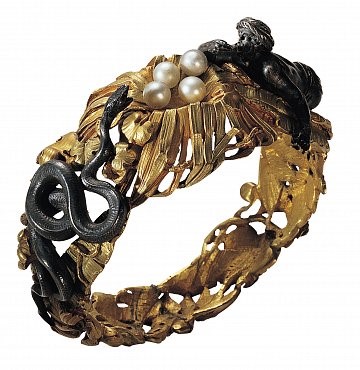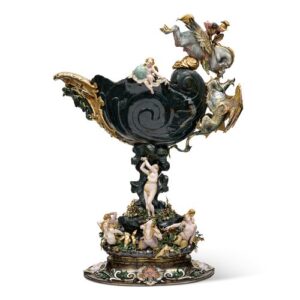
JEWELRY IN THE ROMANTIC ERA
PROF. SERGIO ANSUINI | ROME MARCH 7, 2025
The Napoleonic tsunami, with its eagles, the return to classicism, artistic effectiveness, and lofty ideals, was buried at Waterloo. The reaction, of course, was not long in coming. The farther the pendulum swings in one direction, the more it inevitably swings back the other way. This has happened and continues to happen in every era. A vast movement took hold across Europe. Nature, individual emotions, and pathos were rediscovered. Baroque, which had been crushed first by the tree of liberty and then by the imperial road, timidly resurfaced, giving way to Romanticism. A shared sensibility united Schumann, Chopin, Turner, Géricault, and Hayez with Byron, Shelley, and Leopardi.
The Posillipo School, partly influenced by foreign artists such as Turner, flourished in Naples, which, along with Milan, was one of the centers where the hesitant Italian Romanticism took root.

(Musée de la Vie Romantique)
The Musée de la Vie Romantique in Paris highlighted the development and creativity of French goldsmiths between 1814 and 1848 through a dedicated exhibition. Romantic ideals influenced jewelry with new themes and new crafting techniques. Paintings from the 14th, 15th, and 16th centuries were carefully studied. Ghiberti, Michelangelo, Dürer, and Cellini were taken as models, while influences from Louis XV and the beauty of the rocaille style were also incorporated. There was a strong fascination with the Orient, though often transformed by the imagination of the creators. Nature became a significant source of inspiration.
While the Industrial Revolution introduced mass production to jewelry-making, part of the craft, requiring exceptional skill, became the domain of an elite group of jewelers whose ambition was to create true works of art.
This artistic jewelry movement was pioneered by Charles Wagner (1799–1841). Of German origin, he moved to Paris early in life, excelling in goldsmithing. Together with his brother-in-law Augustin Médard Mention, he specialized in niello work, successfully breaking the Russian monopoly on this technique. They developed and patented various goldsmithing techniques, including a special platinum alloy. Wagner drew inspiration from Gothic and Renaissance styles in his jewelry creations. Beyond Wagner, some of the leading figures in Romantic jewelry included Froment-Meurice, whom we previously encountered regarding the commission for the Sword of the Count of Paris, and his workshop master Jules Wiese. Another significant name was Jean Valentin Morel (1794–1860). His life was turbulent, alternating between periods of wealth and severe financial hardship. His father introduced him to lapidary art, and he later apprenticed under master goldsmith Adrien Vachette. In 1834, he became the head craftsman at the prestigious jeweler Fossin, which he eventually left to enter into partnership with the celebrated dandy and architect Henri Duponchel—an eclectic director of the Opéra de Paris and a friend of Guerin and Delacroix. This collaboration led to the founding of Morel & Cie, an internationally acclaimed maison. However, the renowned atelier, which employed dozens of artisans, was forced to close in 1846 due to a legal dispute between the partners. The court ruling was devastating for Morel, as he lost everything—including the right to work in Paris. He attempted to establish himself in London, partnering with Fossin’s son, but despite gaining recognition and success, financial difficulties ultimately led to failure. In 1853, Morel returned to France and set up a workshop in Sèvres, just outside the forbidden Paris. There, he worked with a small circle of dedicated admirers and received commissions from Jules Fossin. He passed away in 1860.
Morel’s creativity and goldsmithing skills were undeniable. He had learned from the best and was surrounded by artists who elevated his craftsmanship. He received numerous awards and participated in international exhibitions.

(The Hope Cup – Jean-Valentin Morel)
A masterpiece of 19th-century lapidary art, the famous Hope Cup was crafted by Morel during his time in Sèvres. The cup was presented at the 1855 Paris Exposition and was acquired in 2024 by the Musée d’Orsay in New York. Standing 65 cm tall and weighing approximately 16 kg, it was created under the direction of the renowned goldsmith in collaboration with exceptional artists. The flowers and plants are crafted in the style of the 16th century, and the entire piece conveys a strong dramatic presence.